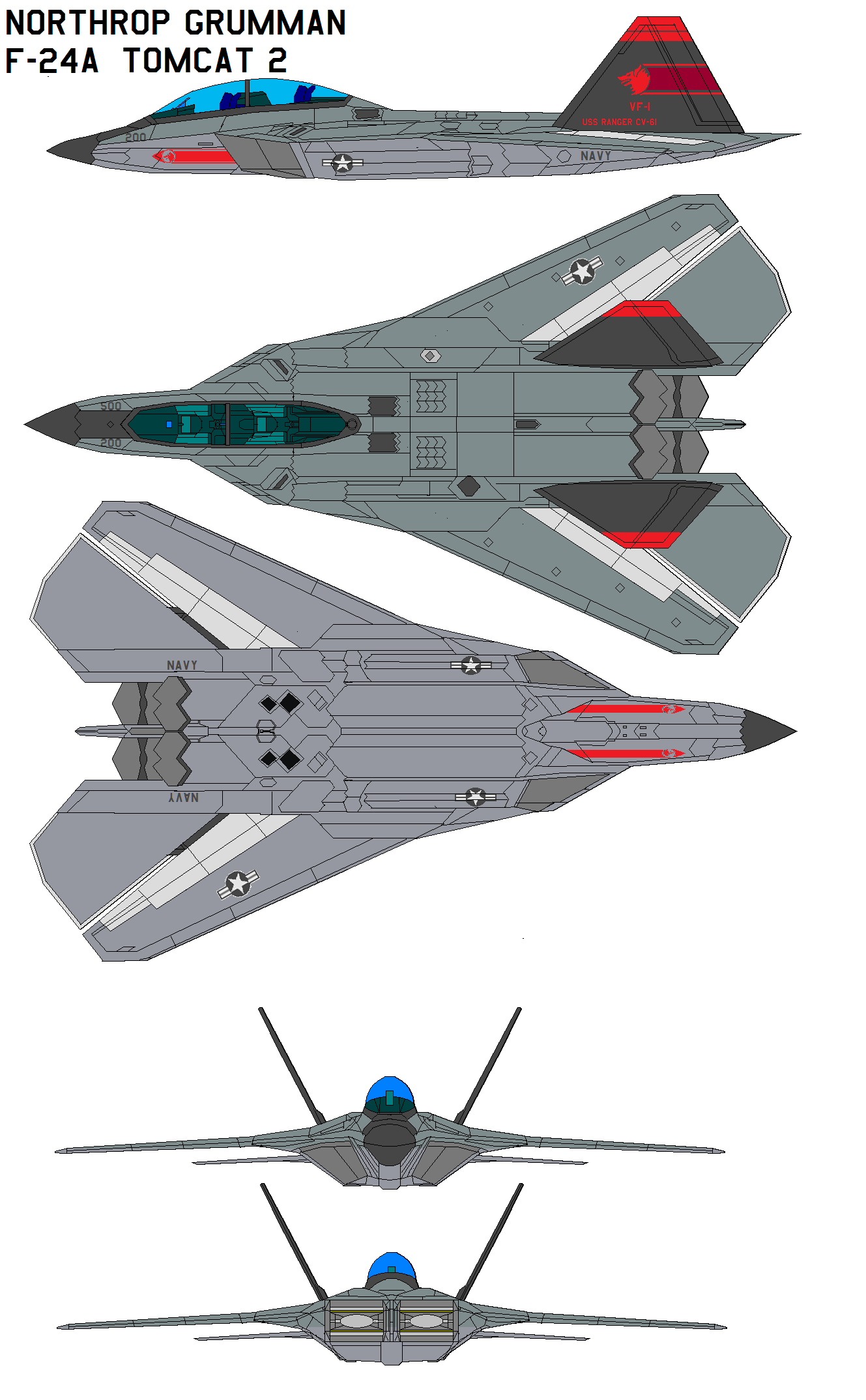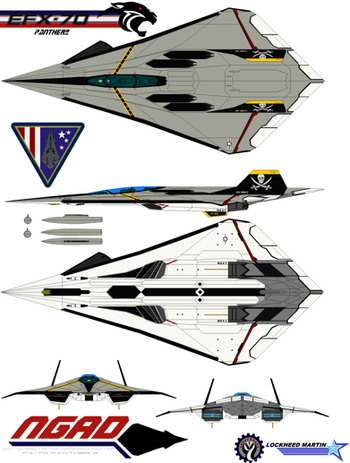HOME | DD
 bagera3005 — Northrop Grumman F-24A Tomcat
by
bagera3005 — Northrop Grumman F-24A Tomcat
by

Published: 2011-09-09 00:44:51 +0000 UTC; Views: 14960; Favourites: 102; Downloads: 426
Redirect to original
Description
Northrop Grumman F-24A Tomcat 2Naval Advanced Tactical Fighter (NATF) 1988-1991
Due to Congressional intervention, the US Navy agreed to evaluate a navalized version of the US Air Force's Advanced Tactical Fighter (now the F/A-22) as a possible replacement for their F-14s. In return, the US Air Force would evaluate a derivative of the ATA as a replacement for their F-111s.
In late 1988, a Naval ATF (NATF) program office was set up at Wright-Patterson Air Force Base and the existing ATF Dem/Val contracts were modified to include studies of potential NATF variants.
The Major Aircraft Review reduced the peak production rates of both the ATF and NATF. This had the effect of substantially increasing the program cost. In August 1990, Admiral Richard Dunleavy, who was in charge of Navy aircraft requirements, stated that he did not see how the NATF could fit into any affordable plan for naval aviation. In early 1991, before the final contractor for the ATF was even selected, the consideration of the NATF was dropped. This was mainly due to the fact that the Navy realized that a series of upgrades to their existing F-14's could meet the Navy's air superiority needs through 2015.
The F-22N was studied in the Major Aircraft Review as an NATF concept, and canceled in large measure because the projected high gross take-off weight exceed the capacity of current carriers.
Carrier aircraft fly slower approaches than land-based aircraft and must be able to perform a waveoff at low speed. Therefore, a full power 1.5g turn at 0.2M and sea level with all stores and reserve fuel on board may be needed to ensure an adequate maneuver margin. This requirement determines the wing loading for sea-based aircraft [the SSF was exempt from this waveoff requirement because it performs vertical landings].
Carrier operations require heavier structures for several reasons: 1) arrested landings require a tail hook and reinforced fuselage, 2) landing gear are designed for 24 ft/s sink rate, and 3) catapult launches require reinforced nose gear and a strengthened fuselage. These weight increments are difficult to quantify because there are no data for aircraft that were designed for both land-based and sea-based operations with exactly the same mission capability. For example, contrary to the expected navalization penalty, the land-based F-4 actually had a higher empty weight than the carrier-based version. But in this case the land-based version used the increased strength and wing area of the carrier aircraft to carry an increased equipment load, which equates to higher mission capability. Similarly, few aircraft have successfully made the transition from land-based to sea-based operations. The carrier version of the British Hawk did perform catapult launches and arrested landings but required substantial structural reinforcement to do so. The navalized Hawk is approximately 11% heavier empty, but it can no longer fly as far as the land-based version.
Since historical research did not provide values for fuselage and landing gear weight penalties for carrier operations, an estimate had to be made another way. To this end, the F-14 and F-18 were modelled using ACSYNT's land-based weight equations. The actual aircraft fuselage and landing gear structure weights were approximately 30% greater than those modelled by ACSYNT. Therefore, 30% fuselage and landing gear weight penalties may be applied to carrier-based aircraft in this study. Informal comments by US Navy personnel agreed that 30% was a reasonable estimate.
Early in the ATF/NATF development, a Naval variant of the F-22 could have been developed. By the late 1990s, however, to graft a Naval requirement onto an existing F-22 program would be similar to the mistake that the Department made in developing the F-111. In that program, DOD directed the Air Force to add Naval requirements to an existing Air Force EMD concept "with minimal disruption" to the program. As a result, the Naval version of the F-111 was significantly overweight and subsequently canceled in favor of a new start Navy aircraft, the F-14. The appropriate time to join multi-service requirements is early in the program, and the ideal time is while the requirements are being developed in a balanced systems engineering approach.
General characteristics
* Crew: 2
* Length: 18.80 m (61 ft 8 in)
* Wingspan: Wingspan, fully forward: 20.62 m (67 ft 8 in)
* Height: ll: 4.52 m (14 ft 10 in)
* Wing area: 1000 ft²
* Empty weight: 30,000 lb
* Loaded weight: 60,600 lb
* Max takeoff weight: 65,000 lb
* Powerplant: 2× G Pratt & Whitney YF220 , 65,000 lbf
Performance
* Maximum speed: Mach 2.34 (1,544 mph, 2,485 km/h) at high altitude
* Combat radius: 500 nmi (575 mi, 926 km)
* Ferry range: 1,600 nmi (1,840 mi, 2,960 km)
* Service ceiling: 50,000 ft (15,200 m)
* Rate of climb: >45,000 ft/min (229 m/s)
* Wing loading: 113.4 lb/ft² (553.9 kg/m²)
* Thrust/weight: 0.91
Armament
* Guns: 1× 20 mm (0.787 in) M61 Vulcan 6-barreled gatling cannon, with 675 rounds
* Hardpoints: 10 total: 6× under-fuselage, 2× under nacelles and 2× on wing gloves[87][N 2] with a capacity of 14,500 lb (6,600 kg) of ordnance and fuel tanks[36]
* Missiles:
o Air-to-air missiles: AIM-54 Phoenix, AIM-7 Sparrow, AIM-9 Sidewinder
o Air-to-air missiles:
+ AIM-120 AMRAAM
+ AIM-132 ASRAAM
+ AIM-9X Sidewinder
o Air-to-ground weapons:
4× AGM-88 HARM
+ AGM-154 JSOW
+ AGM-158 JASSM
Related content
Comments: 26

Oh come on I forgot you made one I got that same 💡 but I may still try it but I may use this and the f-14 as a base
👍: 0 ⏩: 1

i may do one more based on f-14 later
👍: 0 ⏩: 1

Do you mind if I try to make a shipbucket use model for this and mod the bio a bit
and do the wings move
👍: 0 ⏩: 1

Did you base this off the Lockheed / boeing a/f-x program cause silver 70chev aircraft parts 1 has a plane that looks like so much like this
👍: 0 ⏩: 1

Wings yes to moving no to the banshee thing
they do look like twins
Just look at it
👍: 0 ⏩: 1

So nutshell I could use his banshee in a recoloring for tomcat 2
👍: 0 ⏩: 1

Good cause I did updating my colors of your panther 2 soon
👍: 0 ⏩: 1

And wings open yes or no cause I found someone made a shipbucket scale plane that looks like this
👍: 0 ⏩: 1

The f-24 banshee looks like her sister
👍: 0 ⏩: 1

armament seems to be the same as the original Tomcat but it has all new systems and weapons bays and stuff. Shouldn't it be able to carry more and do more?
👍: 0 ⏩: 0

Just one quibble with the markings, VF-1 would've had side numbers in the 1xx range, starting from 100, VF-2 had numbers in the 2xx range, again starting at 200. Otherwise, nice work.
👍: 0 ⏩: 0

Looks like the Turbokat from the SWAT Kats cartoon show! Total win! Make a Turbokat livery on this one, p-p-please!
👍: 0 ⏩: 1

Addendum: [link]
👍: 0 ⏩: 0

Nice, and yea, they definetly need a new platform to deploy phoenix missiles from.
The F-14 was my favorite active US military jet. It has the same principle as the P51 Mustang, if it looks good, it probably is.
👍: 0 ⏩: 0

I'd love for the Tomcat to be reborn. The Navy needs a fighter that can compete with the Air Force's primary fighter in the dogfight. More importantly, the Navy needs a fighter that is infinitely cooler than anything the Air Force ever owned. Big shoes to fill, but I think Iron Works is up to the challenge.
I always feel these NATF based designs look off. The broad body isn't there, and the stabilizer points. Am I the only one who thinks this?
👍: 0 ⏩: 0

General characteristics
* Crew: 1
* Length: 18.80 m (61 ft 8 in)
* Wingspan: Wingspan, fully forward: 20.62 m (67 ft 8 in)
* Height: ll: 4.52 m (14 ft 10 in)
* Wing area: 1000 ft²
* Empty weight: 30,000 lb
* Loaded weight: 60,600 lb
* Max takeoff weight: 65,000 lb
* Powerplant: 2× G Pratt & Whitney YF220 , 65,000 lbf
If it's a single seater, why does it have a tandem cockpit?
👍: 0 ⏩: 0





















